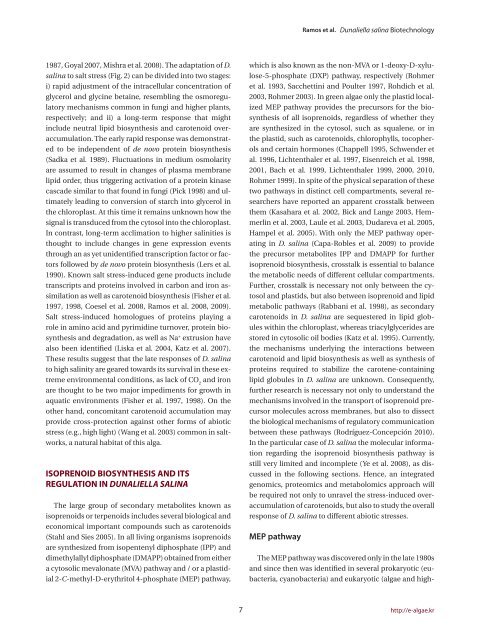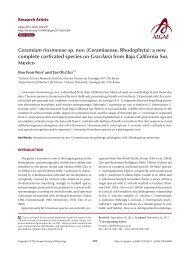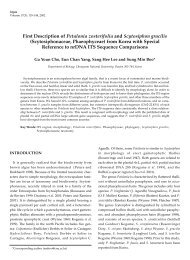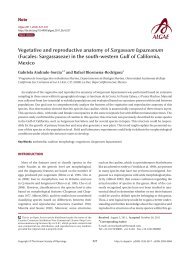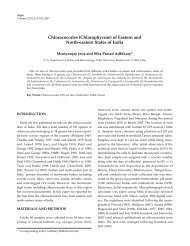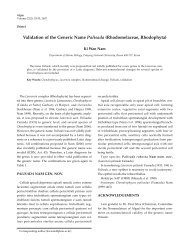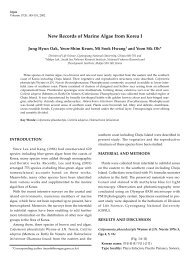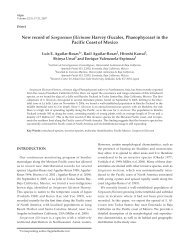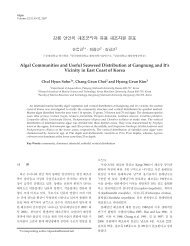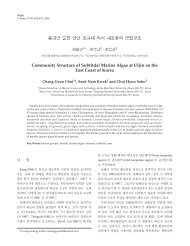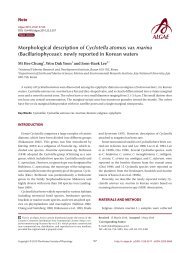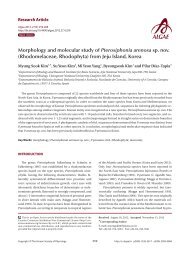The unicellular green alga Dunaliella salina Teod. as a model - Algae
The unicellular green alga Dunaliella salina Teod. as a model - Algae
The unicellular green alga Dunaliella salina Teod. as a model - Algae
You also want an ePaper? Increase the reach of your titles
YUMPU automatically turns print PDFs into web optimized ePapers that Google loves.
1987, Goyal 2007, Mishra et al. 2008). <strong>The</strong> adaptation of D.<br />
<strong>salina</strong> to salt stress (Fig. 2) can be divided into two stages:<br />
i) rapid adjustment of the intracellular concentration of<br />
glycerol and glycine betaine, resembling the osmoregulatory<br />
mechanisms common in fungi and higher plants,<br />
respectively; and ii) a long-term response that might<br />
include neutral lipid biosynthesis and carotenoid overaccumulation.<br />
<strong>The</strong> early rapid response w<strong>as</strong> demonstrated<br />
to be independent of de novo protein biosynthesis<br />
(Sadka et al. 1989). Fluctuations in medium osmolarity<br />
are <strong>as</strong>sumed to result in changes of pl<strong>as</strong>ma membrane<br />
lipid order, thus triggering activation of a protein kin<strong>as</strong>e<br />
c<strong>as</strong>cade similar to that found in fungi (Pick 1998) and ultimately<br />
leading to conversion of starch into glycerol in<br />
the chloropl<strong>as</strong>t. At this time it remains unknown how the<br />
signal is transduced from the cytosol into the chloropl<strong>as</strong>t.<br />
In contr<strong>as</strong>t, long-term acclimation to higher salinities is<br />
thought to include changes in gene expression events<br />
through an <strong>as</strong> yet unidentified transcription factor or factors<br />
followed by de novo protein biosynthesis (Lers et al.<br />
1990). Known salt stress-induced gene products include<br />
transcripts and proteins involved in carbon and iron <strong>as</strong>similation<br />
<strong>as</strong> well <strong>as</strong> carotenoid biosynthesis (Fisher et al.<br />
1997, 1998, Coesel et al. 2008, Ramos et al. 2008, 2009).<br />
Salt stress-induced homologues of proteins playing a<br />
role in amino acid and pyrimidine turnover, protein biosynthesis<br />
and degradation, <strong>as</strong> well <strong>as</strong> Na + extrusion have<br />
also been identified (Liska et al. 2004, Katz et al. 2007).<br />
<strong>The</strong>se results suggest that the late responses of D. <strong>salina</strong><br />
to high salinity are geared towards its survival in these extreme<br />
environmental conditions, <strong>as</strong> lack of CO 2 and iron<br />
are thought to be two major impediments for growth in<br />
aquatic environments (Fisher et al. 1997, 1998). On the<br />
other hand, concomitant carotenoid accumulation may<br />
provide cross-protection against other forms of abiotic<br />
stress (e.g., high light) (Wang et al. 2003) common in saltworks,<br />
a natural habitat of this <strong>alga</strong>.<br />
ISOPRENOID BIOSYNTHESIS AND ITS<br />
REGULATION IN DUNALIELLA SALINA<br />
<strong>The</strong> large group of secondary metabolites known <strong>as</strong><br />
isoprenoids or terpenoids includes several biological and<br />
economical important compounds such <strong>as</strong> carotenoids<br />
(Stahl and Sies 2005). In all living organisms isoprenoids<br />
are synthesized from isopentenyl diphosphate (IPP) and<br />
dimethylallyl diphosphate (DMAPP) obtained from either<br />
a cytosolic mevalonate (MVA) pathway and / or a pl<strong>as</strong>tidial<br />
2-C-methyl-D-erythritol 4-phosphate (MEP) pathway,<br />
Ramos et al. <strong>Dunaliella</strong> <strong>salina</strong> Biotechnology<br />
which is also known <strong>as</strong> the non-MVA or 1-deoxy-D-xylulose-5-phosphate<br />
(DXP) pathway, respectively (Rohmer<br />
et al. 1993, Sacchettini and Poulter 1997, Rohdich et al.<br />
2003, Rohmer 2003). In <strong>green</strong> <strong>alga</strong>e only the pl<strong>as</strong>tid localized<br />
MEP pathway provides the precursors for the biosynthesis<br />
of all isoprenoids, regardless of whether they<br />
are synthesized in the cytosol, such <strong>as</strong> squalene, or in<br />
the pl<strong>as</strong>tid, such <strong>as</strong> carotenoids, chlorophylls, tocopherols<br />
and certain hormones (Chappell 1995, Schwender et<br />
al. 1996, Lichtenthaler et al. 1997, Eisenreich et al. 1998,<br />
2001, Bach et al. 1999, Lichtenthaler 1999, 2000, 2010,<br />
Rohmer 1999). In spite of the physical separation of these<br />
two pathways in distinct cell compartments, several researchers<br />
have reported an apparent crosstalk between<br />
them (K<strong>as</strong>ahara et al. 2002, Bick and Lange 2003, Hemmerlin<br />
et al. 2003, Laule et al. 2003, Dudareva et al. 2005,<br />
Hampel et al. 2005). With only the MEP pathway operating<br />
in D. <strong>salina</strong> (Capa-Robles et al. 2009) to provide<br />
the precursor metabolites IPP and DMAPP for further<br />
isoprenoid biosynthesis, crosstalk is essential to balance<br />
the metabolic needs of different cellular compartments.<br />
Further, crosstalk is necessary not only between the cytosol<br />
and pl<strong>as</strong>tids, but also between isoprenoid and lipid<br />
metabolic pathways (Rabbani et al. 1998), <strong>as</strong> secondary<br />
carotenoids in D. <strong>salina</strong> are sequestered in lipid globules<br />
within the chloropl<strong>as</strong>t, where<strong>as</strong> triacylglycerides are<br />
stored in cytosolic oil bodies (Katz et al. 1995). Currently,<br />
the mechanisms underlying the interactions between<br />
carotenoid and lipid biosynthesis <strong>as</strong> well <strong>as</strong> synthesis of<br />
proteins required to stabilize the carotene-containing<br />
lipid globules in D. <strong>salina</strong> are unknown. Consequently,<br />
further research is necessary not only to understand the<br />
mechanisms involved in the transport of isoprenoid precursor<br />
molecules across membranes, but also to dissect<br />
the biological mechanisms of regulatory communication<br />
between these pathways (Rodríguez-Concepción 2010).<br />
In the particular c<strong>as</strong>e of D. <strong>salina</strong> the molecular information<br />
regarding the isoprenoid biosynthesis pathway is<br />
still very limited and incomplete (Ye et al. 2008), <strong>as</strong> discussed<br />
in the following sections. Hence, an integrated<br />
genomics, proteomics and metabolomics approach will<br />
be required not only to unravel the stress-induced overaccumulation<br />
of carotenoids, but also to study the overall<br />
response of D. <strong>salina</strong> to different abiotic stresses.<br />
MEP pathway<br />
<strong>The</strong> MEP pathway w<strong>as</strong> discovered only in the late 1980s<br />
and since then w<strong>as</strong> identified in several prokaryotic (eubacteria,<br />
cyanobacteria) and eukaryotic (<strong>alga</strong>e and high-<br />
7 http://e-<strong>alga</strong>e.kr


